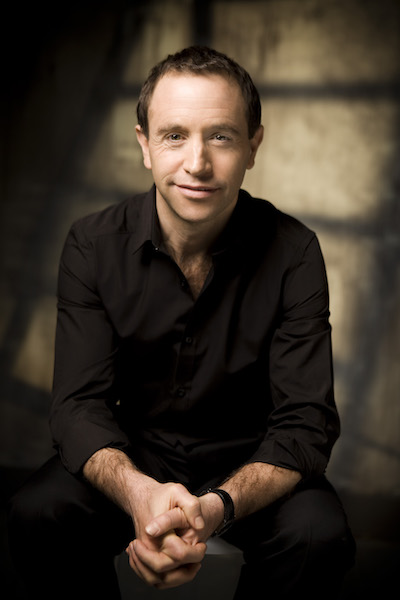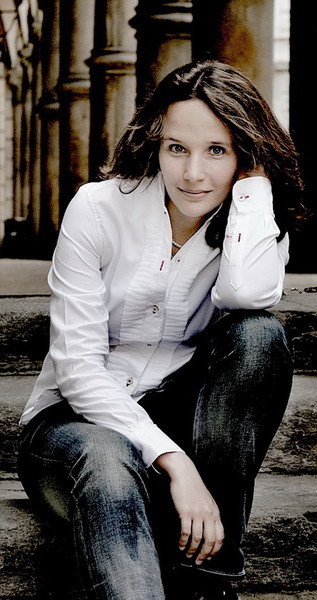Wigglesworth leads New World in thrilling and expressive Mahler

Mark Wigglesworth conducted the New World Symphony in music of Mozart, Ravel and Mahler Saturday night at the Arsht Center. Photo: Ben Ealovega
French pianist Hélène Grimaud was the featured attraction at the New World Symphony’s concert at the Arsht Center on Saturday night but it was an exceptionally sensitive and expressive performance of Mahler’s First Symphony that proved the concert’s memorable event. British conductor Mark Wigglesworth, a frequent New World guest, was on the podium and proved equally adept at the stylistically varied scores of Mozart and Ravel as well.
The New World fellows have been playing with exceptional polish and ensemble cohesion this season and they demonstrated that esprit de corps at the program’s outset in Mozart’s Overture to The Magic Flute. This was spirited, brisk Mozart, definitely a curtain-raiser rather than a symphonic main course. Wigglesworth favored spare string vibrato and his expert balancing of the wind parts blended seamlessly into the ensemble’s classically based sonority.
Ravel’s Piano Concerto in G Major was the French master’s last major work. During an American concert tour in 1928, Ravel spent an evening in the jazz clubs of Harlem with George Gershwin and the concerto was strongly influenced by those new American sounds that were sweeping Europe.
Grimaud’s steely technique was better suited to the rapid pianistic display of the outer movements than the dreamy central Adagio assai. Her tempo in the opening Allegramente was on the slow side but she drew out the bluesy phrases and had the strength and accuracy for the power-pounding octaves. Wigglesworth made every orchestral detail count; Chloe Tula’s harp solo was clear and elegantly shaped.
Unfortunately, in the slow movement, one of Ravel’s loveliest creations, Grimaud’s playing was merely efficient, lacking the Gallic elegance beneath the notes. Johanna Gruskin’s shiny flute solo captured more of the movement’s sensual beauty. Grimaud took the final Presto at a frantic pace, in an approach closer to Gershwin than to Ravel’s fusion of classical and populist elements. The tonal sheen of Francisco Joubert Bernard’s solo bassoon stood out amid a strong orchestral contribution, whipped up to fever pitch by Wigglesworth.
Clearly an audience favorite, Grimaud played two Rachmaninoff preludes as encores, demonstrating a softer touch as well as her power.
From the violins’ very soft pianissimo that launches Mahler’s Symphony No. 1, Wigglesworth evidenced the command and musicianship of a first-rate Mahlerian. The offstage trumpet calls and sound of the cuckoo in the countryside were exquisitely etched into the instrumental fabric. Wigglesworth induced a natural sense of flow and pacing at the cellos’ introduction of the movement’s principal theme and built the climaxes with a steady hand. Giovanni Bertoni’s molten clarinet and Ryan Roberts’ bright oboe brought character to the bird calls and the all-important harp part came through clearly even with the large forces. The final brass climax was sonorous and exultant.
Wigglesworth conveyed the robust country dance of the second movement but took the central Landler at a more leisurely pace. In a movement that is often played for sheer volume, finely variegated dynamics made the big moments all the more effective.
The Frère Jacques melody that opens the third movement is usually played by a solo double bass but Wigglesworth had the full bass section play the theme and their precision and deep tone made the change highly effective. A sense of longing and nostalgia pervaded the klezmer episodes, with Bertoni’s tangy clarinet sounding like an authentic Eastern European wedding band. Throughout the shifting currents of the movement, Wigglesworth maintained absolute control without micro-managing details.
The crashing chords that commenced the finale sounded aptly cataclysmic and Wigglesworth’s headlong tempo more than matched Mahler’s marking of “stormy and agitated.” The lyrical string interludes seemed to come from another world and the reprise of the symphony’s opening was magical, Wigglesworth bringing the strings down to a barely audible whisper. Elizabeth Lu’s silvery flute, Aaron Ney’s resounding trumpet and Corbin Castro’s mellow horn were outstanding in solo moments.
Wigglesworth brought unusual emotional intensity to the buildup to the climactic brass proclamation. With the eight horns standing, as Mahler requests, the final pages were thrilling. A contingent of extra players blended splendidly with the New World’s season roster in a reading that probed the joys and depths of Mahler’s symphonic persona.
Bernard Labadie conducts the New World Symphony in selections from Handel’s Ariodante, Haydn’s Sinfonia concertante and Mozart’s Symphony No. 40, 8 p.m. April 6 and 2 p.m. April 7 at the New World Center in Miami Beach. nws.edu; 305-673-3331
Posted in Performances
One Response to “Wigglesworth leads New World in thrilling and expressive Mahler”
Leave a Comment
Sun Mar 17, 2019
at 12:56 pm
1 Comment








Posted Mar 24, 2019 at 9:47 am by Sandra Ross
I loved the Mahler. Wish there was more. I personally was disappointed in Grimaud!
For me the week before at NWS the Israeli pianist was amazing??
Wigglesworth, conducted superbly.